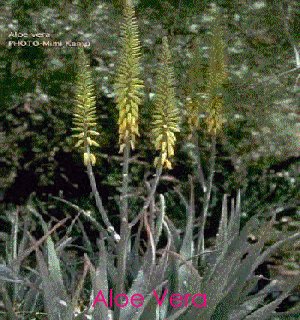
Aloe Vera
Michelle Giesler and Kimberly Jones

I. General Description
A. Location: dry regions of Africa, Asia, Europe, and America
B. Plant Characteristics:
C. Part harvested for medicinal effects: LEA
II. Chemical Composition
A. Active Compounds
- Anthraquinones (aloin, barbaloin, aloe-emodin): cathartics
- Saccharides (acetylated mannose): antiviral and immunopotentiating action
- Prostaglandins and fatty acids (gamma-linoleic acid....prostaglandin 1 series): favorable effects on inflammation, allergy, platelet aggregation, wound healing
- Others: enzymes, amino acids, vitamins, minerals
B. Other Compounds:
III. History and Folk Use
IV. Pharmacology
Antibacterial and antifungal
Antiviral: acemannan
Immune enhancement: acemannan
Anti-allergy and anti-inflammatory: glycoproteins and anthraquinones
Wound healing
V. Clinical Applications
Oral: constipation, immune system enhancement, diabetes, asthma, viral infections (internal use of Aloe Vera is not generally recommended)
Topical: wound healing (antimicrobial), burn healing (especially from radiation), frostbite healing (vasodilation), mouth ulcer healing, anti-inflammatory, moisturizer, and emollient
VI. Toxicity
VII. Drug and Disease Interactions
VIII. Dosage
**Look for stabilized products if the gel is not used directly from the plant**
Clincal Trials
Miller et al. compared the therapeutic effects of systemic pentoxifylline and topical aloe vera cream in the treatment of frostbite on the ears of 10 white rabbits. The four treatment groups included untreated controls, treatment with aloe cream, treatment with pentoxifylline, and treatment with aloe cream + pentoxifylline. The control group had a 6% tissue survival, 20% with pentoxifylline, 24% with aloe cream, and 30% with combined therapy. All treatment groups had significantly improved tissue survival compared with the control ears (p<0.05), and no statistically significant difference was found among treatment groups.
Karaca et al. examined the production of reactive nitrogen intermediates by chicken spleen cells and cells of HD11 line (chicken macrophage cell line) in response to acemannan, a complex carbohydrate extracted from aloe vera. Nitric oxide, produced by macrophages, has many effects on tissues including acting as a cytotoxic effects in the killing of tumor cells and parasites, and mediating immune regulation and host defenses in mammalian and avian species. All preparations produced detectable amounts of NO and a dose-response relationship was evident, but no p value was given.
Davis et al. showed that aloe vera, at doses of 100 and 300 mg/kg/day for 4 days, blocked the wound healing suppression of hydrocortisone acetate up to 100% and increased tensile strength above an aqueous control, using the wound tensile strength assay (all p values < 0.005). Also, the sterols in aloe (lupeol, camp-esterol, and beta-sitosterol) proved to have significant anti-inflammatory effects and showed a dose-response relationship.
Table 1: Aloe Vera blocks the hydrocortisone Acetate inhibition on wound healing and tensile strengthTreatment (mg/kg) Change in Wound Tensile Strength
- 0.01 hydrocortisone acetate -26.7 +/- 2.4
- +100 aloe +51.5 +/- 3.1
- +300 aloe +39.4 +/- 1.7
- 0.1 hydrocortisone acetate -17.8 +/- 1.0
- +100 aloe +40.5 +/- 3.9
- +300 aloe +24.3 +/- 2.1
- 1.0 hydrocortisone acetate -46.7 +/- 6.8
- +100 aloe +66.7 +/- 6.7
- +300 aloe +100 +/- 7.9
Table 2: Topical Anti-Inflammatory Activity of Three Sterols Found in Aloe Vera Applied at 100 mcg Doses on Croton Oil-Induced Edema
Sterols Inhibition
Lupeol 37.0 +/- 4.3
B-Sitosterol 31.1 +/- 2.9
Campesterol 24.2 +/- 1.9
Tagi et al. isolated the glycoprotein fraction from aloe vera gel and tested its significance in proliferation-promoting activity on human and hamster cells in vitro. At 100 mcg/mL, 3 subfractions of the active fraction increased growth activity by 5, 20, and 27%, but no p value was given.
Davis et al examined the possibility of mannose-6-phosphate, the major sugar in aloe vera gel, being an active growth substance. Mice receiving 300 mg/kg of mannose-6-P had improved wound healing (wound diameter decrease of 50.7%) over saline controls (42.1% reduction) with a p value < 0.01. This dose also had anti-inflammatory activity (ear weight of 5.5 mg) compared to a saline control (7.3 mg), the p value = 0.05.
References:
Castleman, M. The Healing Herbs. Rodale Press, Emmaus, PA. 1991. P. 42-44.
Covington, TR, et al. Handbook of Nonprescription Drugs. American Pharmaceutical Association, Washington DC. 1996. p. 231t, 234, 643, 707-708.
Davis, RH, et al. Anti-inflammatory and wound healing activity of a growth substance in Aloe vera. Journal of the American Podiatric Medical Association. 84(2): 77-81, 1994 Feb.
Davis, RH, et al. Aloe vera, hydrocortisone, and sterol influence on wound tensile strength and anti-inflammation. Journal of the American Podiatric Medical Association. 84(12): 614-21, 1994 Dec.
Dean, K. Plant patents. Herbalgram. 36:20.
Karaca, K., et al. Nitric Oxide production by chicken macrophages activated by Acemannan, a complex carbohydrate extracted from Aloe vera. International Journal of Immunopharmacology. 17(3): 183-8, 1995 March.
McCaleb, R. Aloe Vera Compound Effect against Mouth Ulcers. Herbalgram. 32:12.
Miller, MB, et al. Treatment of experimental frostbite with pentoxifylline and aloe vera cream. Archives of Otolaryngology-Head & Neck Surgery. 121(6): 678-80, 1995 June.
Murray, MD. The Healing Power of Herbs. Prima Publishing, Rocklin, CA. 1996. p. 29-41.
Tyler, VE. The Honest Herbal. Pharmaceutical Products Press, Binghamton, NY. 1993. p. 25-28.
Yagi, A., et al. Isolation and characterization of the glycoprotein fraction with a proliferation-promoting activity on human and hamster cells in vitro from Aloe vera gel. Planta Medica. 63(1): 18-21, 1997 Feb.
Web sites as follows:
http://www.carringtonlbs.com/